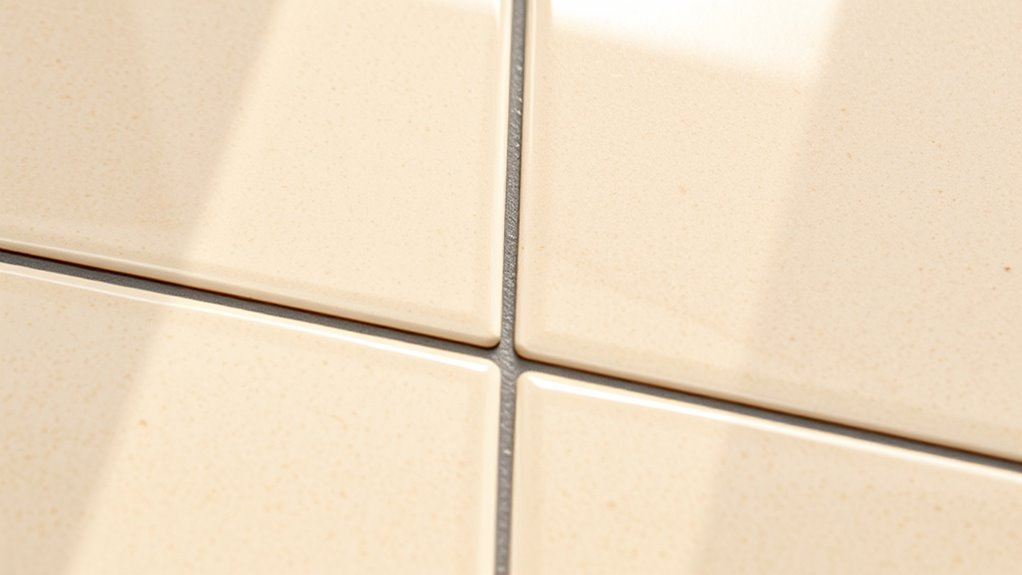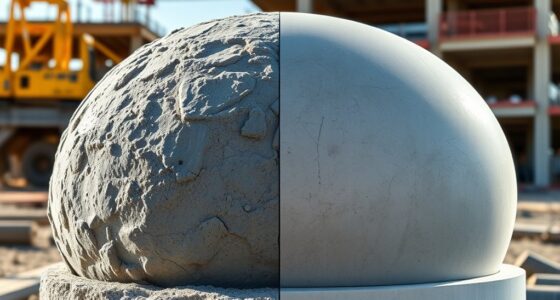To keep the lip perfect in tile expansion and soft joints, focus on proper placement and material selection. Install joints at regular intervals, especially in high-movement areas, with flexible sealants like silicone or polyurethane. Avoid overfilling gaps and ensure straight, even alignment. Using the right materials and techniques prevents damage, cracks, and unsightly gaps. Staying attentive to these details helps maintain a seamless look—continue to explore how these experts keep their tile joints flawless.
Key Takeaways
- Properly install soft joints at regular intervals to accommodate tile movement and prevent cracking or lifting.
- Use flexible sealants like silicone or polyurethane to maintain the lip’s appearance during expansion and contraction.
- Avoid overfilling joints, ensuring enough space for movement without compromising stability or aesthetic appeal.
- Match grout and sealant colors closely to tiles for a seamless, professional finish that maintains the lip’s perfect look.
- Regularly inspect and maintain joints and sealants to address wear early and preserve the tile surface’s integrity and appearance.
Understanding the Importance of Expansion Joints in Tiling
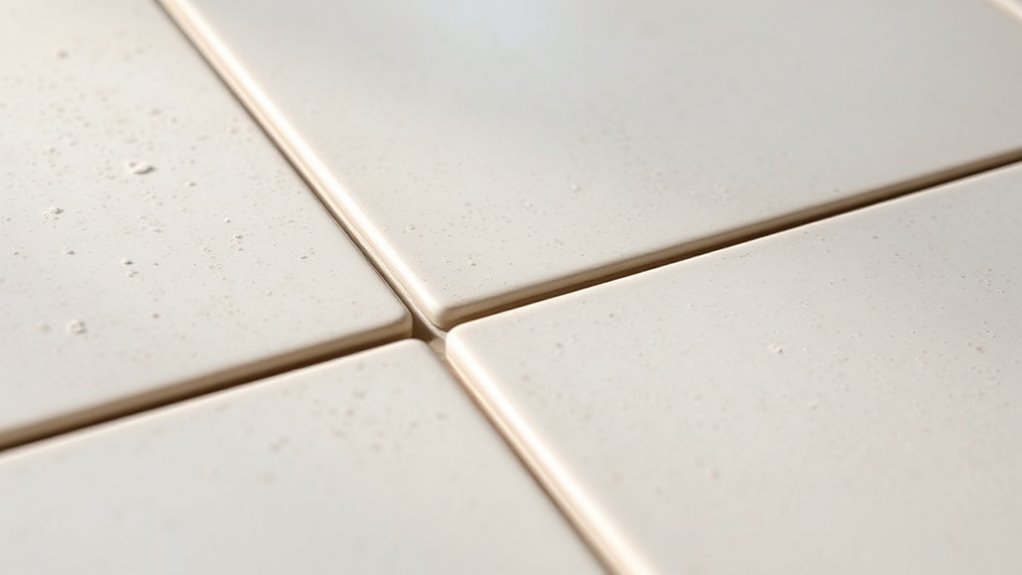
Understanding the importance of expansion joints in tiling is essential because these joints allow for natural movement in the substrate and tiles. Without them, your tiles can crack or buckle as the surface expands and contracts due to temperature changes or settling. Expansion joints provide a designated space for this movement, preventing stress from building up in the tile installation. They also help accommodate slight shifts caused by ground movement or moisture changes. Installing these joints correctly ensures your tiled surface remains durable and visually appealing over time. Additionally, proper joint placement can mitigate the risk of tile damage caused by unforeseen stress or environmental factors. Skipping or improperly placing expansion joints can lead to costly repairs and compromised structural integrity. By understanding their role, you actively protect your investment, keeping your tiles looking perfect and functioning well for years to come.
The Science Behind Tile Movement and Temperature Changes
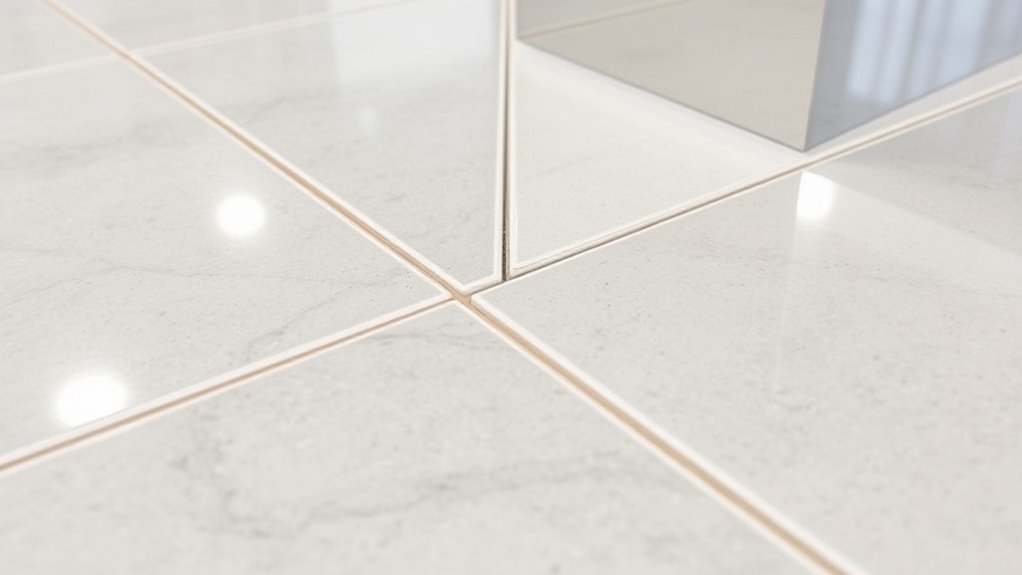
Temperature fluctuations cause tiles to expand and contract, which can lead to cracks or damage if not properly managed. When temperatures rise, tiles expand as their materials absorb heat, increasing in size slightly. Conversely, cooler temperatures cause them to contract, shrinking back to their original dimensions. This movement results from the natural thermal expansion properties of materials like ceramic or porcelain. If tiles are installed without adequate expansion joints or allowances, this continual shifting stresses the adhesive and grout, potentially causing cracks or lifting. Proper installation techniques, including the use of soft joints, are essential to allow for this movement and prevent damage. Understanding this science helps you appreciate why controlling indoor climate and incorporating proper joint spacing is crucial. It ensures your tiled surfaces remain durable and visually appealing, preventing costly repairs caused by unseen stress from temperature-driven tile movement.
Types of Soft Joints and Their Suitable Applications
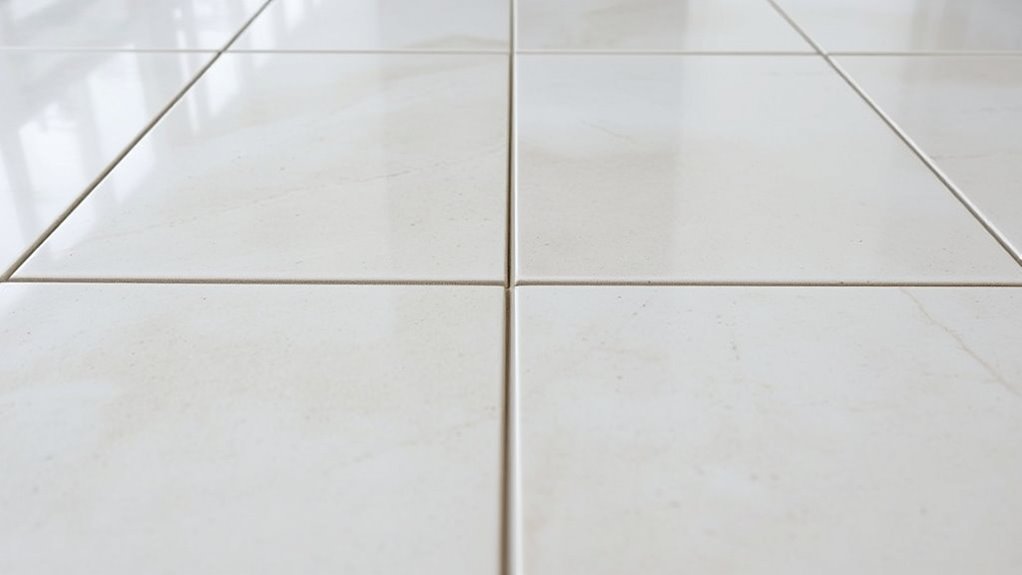
To accommodate the natural movement of tiles caused by temperature changes, soft joints are incorporated into the installation to absorb stress and prevent damage. There are several types of soft joints suited for different applications. Silicone and polyurethane sealants are flexible options ideal for interior spaces, such as bathrooms and kitchens, where movement is moderate. Butyl rubber and acrylic-based sealants work well for exterior areas, like patios and pathways, as they withstand weather fluctuations. For larger joints or areas with significant movement, specialized expansion joint profiles made of flexible materials like vinyl or rubber are recommended. Each type of soft joint offers unique benefits, so you can choose based on the location, expected movement, and exposure to elements, ensuring your tiles stay perfect and damage-free.
Proper Placement of Expansion and Soft Joints in Tile Layouts

Proper placement of expansion and soft joints is essential to allow your tiled surface to move naturally without cracking or buckling. You should install joints at regular intervals, especially in large areas or where different materials meet. Typically, joints are placed every 10 to 15 feet in both directions, depending on the size and material of your tiles. Keep joints aligned across the surface to maintain a clean look and effective movement control. Avoid placing joints too close to edges or corners, as this can weaken the tile structure. Instead, position them strategically in areas with maximum movement potential, such as doorways, transitions, or expansion gaps around the perimeter. Proper placement guarantees your tiles stay intact and look professional over time. Incorporating automation technologies can also help monitor and maintain these joints to prevent issues before they arise.
Materials Used for Soft Joints and Their Benefits
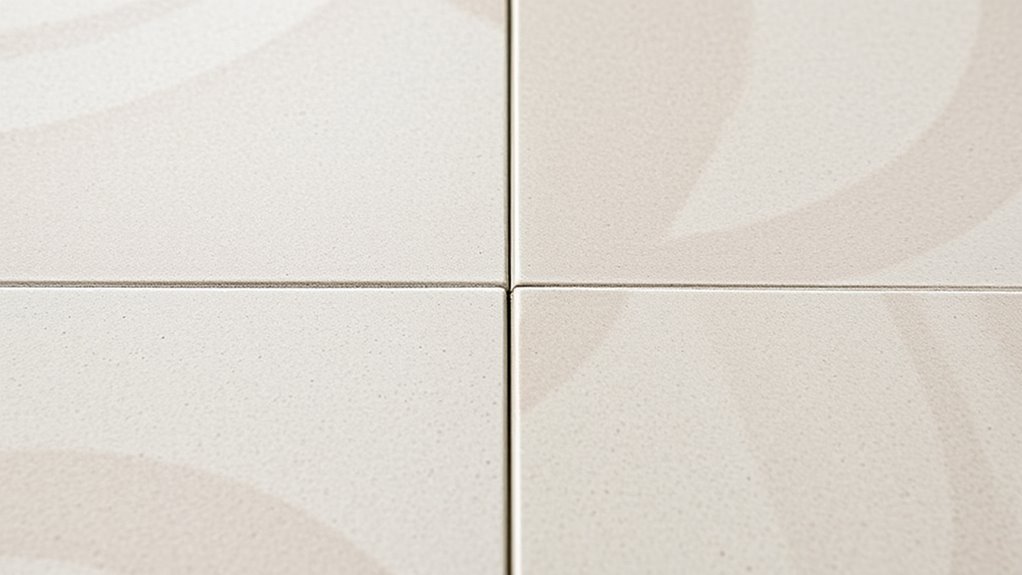
Selecting the right materials for soft joints guarantees that your tiled surface can move freely without cracking or damage. Flexible sealants like silicone, polyurethane, or acrylic are popular choices because they adapt to movement and temperature changes. Silicone offers excellent durability and water resistance, making it ideal for areas exposed to moisture. Polyurethane provides strong adhesion and flexibility, suitable for outdoor or high-traffic zones. Acrylic sealants are easy to apply and paintable, perfect for interior applications. These materials absorb expansion and contraction, preventing stress on tiles. Proper selection directly contributes to the longevity of your tiled surface and keeps your lip edges perfectly intact. Additionally, understanding regional divorce statistics can inform your decision-making process, ensuring you select the most reliable and effective materials for your specific environment.
Step-by-Step Guide to Installing Expansion Joints
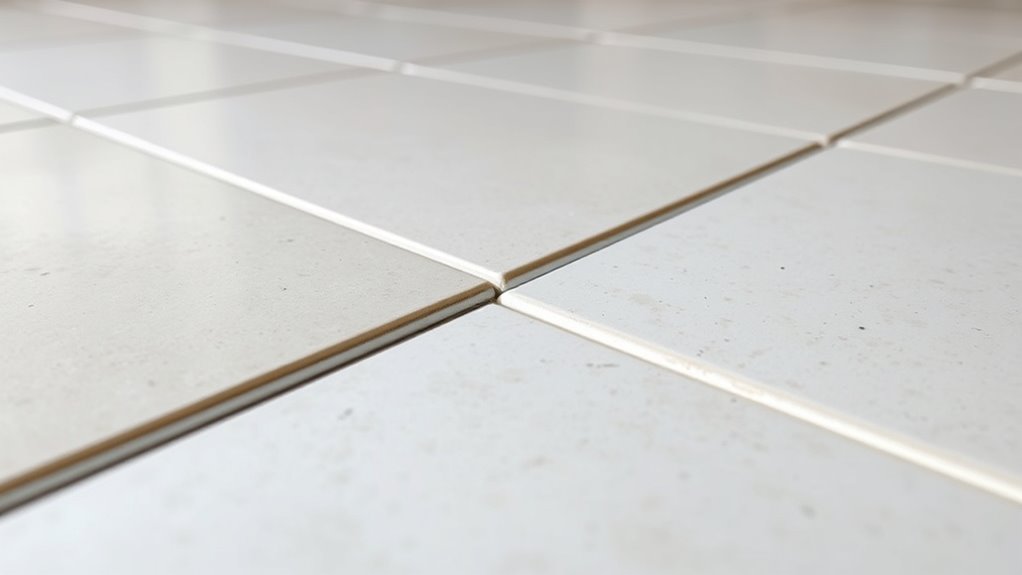
Installing expansion joints correctly is essential for allowing your tiled surface to accommodate movement without cracking. First, decide where the joints should go—typically at transitions, corners, or every 8-12 feet in large areas. Mark these locations clearly. Next, cut the grout line or substrate to the depth of the joint using a saw or chisel. Insert a flexible, weather-resistant material like foam or rubber into the gap, ensuring it’s flush with the tile surface. Apply a sealing or matching grout over the joint to keep it protected from moisture and debris. Proper installation helps your tiles expand and contract smoothly, preventing damage and keeping your surface looking perfect. Proper installation is crucial for maintaining the integrity of the tiled surface over time.
Common Mistakes to Avoid When Creating Soft Joints

One common mistake is overfilling the gap, which can prevent proper movement and cause damage. Ignoring expansion needs leads to cracks and buckling over time. Using the wrong materials for soft joints also compromises their effectiveness and longevity. Additionally, failing to consider caloric intake can lead to insufficient energy for the structure to accommodate movement effectively.
Overfilling the Gap
Overfilling the gap when creating soft joints is a common mistake that can lead to several issues. When you pack too much filler or sealant into the joint, it can cause the material to overflow onto the tile surface, creating a messy appearance. Excess filler also makes it harder for the joint to accommodate movement, increasing the risk of cracking or tile damage over time. Additionally, overfilled joints may not cure properly, reducing their effectiveness and longevity. It’s important to fill the gap just enough to fill the space without overflowing. Use a controlled, steady application and remove excess material promptly. Proper filling ensures the joint remains flexible, functional, and aesthetically pleasing while avoiding future repairs. Choosing the right filler can also help prevent overfilling and ensure long-lasting results.
Ignoring Expansion Needs
Ignoring the expansion needs of tiles and joints can lead to serious problems down the line. Without proper allowances, tiles can crack, lift, or shift over time as they expand and contract with temperature changes. To prevent this, you must plan for expansion gaps and use appropriate joints. Here’s what you need to contemplate:
| Cause | Effect | Solution |
|---|---|---|
| Lack of expansion gaps | Cracking and tile damage | Leave proper gaps during installation |
| Ignoring temperature changes | Increased stress on tiles | Use flexible joint materials |
| Overloading or heavy traffic | Premature joint failure | Reinforce with suitable sealants |
Additionally, understanding the net worth of your property and assets can influence decisions about materials and reinforcement to ensure long-term durability.
Using Wrong Materials
Choosing the wrong materials for soft joints can undermine the entire tile installation, leading to premature failure and costly repairs. Using non-flexible or incompatible sealants may cause cracks, water infiltration, and joint deterioration over time. Avoid cement-based products or hard grouts in joints meant to accommodate movement, as they lack the necessary flexibility. Instead, select high-quality, elastomeric sealants designed for expansion joints, such as silicone or polyurethane-based products. These materials adapt to movement without cracking or losing adhesion. Also, double-check the manufacturer’s specifications to ensure the sealant is suitable for your specific environment, whether wet, outdoor, or high-traffic. Proper material selection helps maintain the lip’s integrity, prevent damage, and extend the lifespan of your tile installation.
Maintenance Tips for Preserving Expansion and Soft Joints
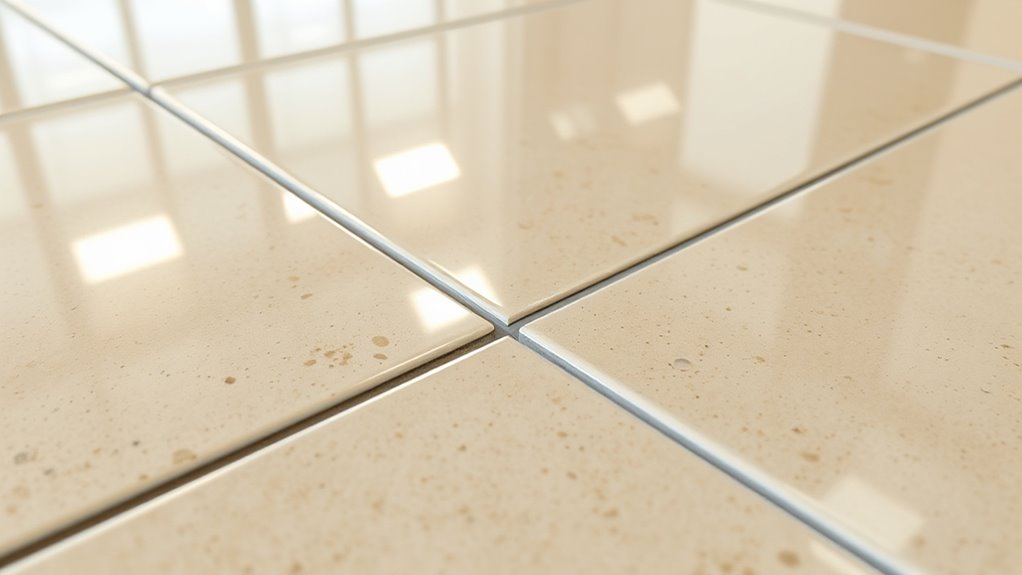
To keep your expansion and soft joints in good shape, you should perform regular inspections to catch any damage early. Using proper cleaning methods helps prevent dirt and debris from accumulating, which can cause joint deterioration. Staying consistent with these maintenance routines guarantees your tiles stay secure and functional over time. Additionally, consulting expert advice on greenhouse construction can provide valuable insights into maintaining joint integrity effectively.
Regular Inspection Routine
Regularly inspecting your tile expansion and soft joints is essential to maintaining their functionality and longevity. You should check for signs of cracking, sagging, or gaps that may indicate wear or damage. Look closely for debris, dirt, or debris buildup that could hinder movement or cause deterioration. Verify the joints remain flexible and haven’t hardened or become brittle over time. Pay attention to areas prone to movement, such as corners or edges, and address issues promptly. Regular inspections help you catch problems early before they worsen, saving you time and money on repairs. Make it a routine to examine your tiles at least once every few months, especially after extreme weather changes or heavy use. Staying proactive keeps your tile system in top condition.
Proper Cleaning Methods
Maintaining the cleanliness of your tile joints is key to preserving their flexibility and preventing damage. Use a soft brush or sponge with warm water and a mild detergent to clean the joints regularly. Avoid harsh chemicals or abrasive scrubbers, as they can deteriorate the soft joints and reduce their lifespan. For stubborn stains or mold, mix a solution of equal parts water and vinegar, then gently scrub the area. Rinse thoroughly with clean water afterward to remove any residue. Dry the joints with a soft cloth to prevent moisture buildup, which can cause mold growth or joint deterioration. Consistent cleaning helps keep your tile expansion and soft joints in good shape, ensuring they stay flexible, functional, and visually appealing over time.
How to Achieve a Seamless Look With Joints in Tiling

Achieving a seamless look with joints in tiling requires careful planning and precise execution. To get started, choose tiles with consistent sizes and opt for a thin, uniform grout line. Properly align each tile during installation, ensuring joints are straight and evenly spaced. Use spacers to maintain uniform gaps, which helps create a cleaner appearance. When grouting, select a color that closely matches your tiles to minimize visual breaks. Clean excess grout promptly to prevent haze and unevenness. Here’s a quick guide:
| Step | Tip | Result |
|---|---|---|
| Use consistent tiles | Measure tiles before installation | Uniform appearance |
| Maintain spacing | Use spacers throughout | Even grout lines |
| Choose matching grout | Pick grout close to tile color | Seamless look |
| Proper cleaning | Clean grout after application | Professional finish |
| Check alignment | Use a level or straight edge | Straight, seamless joints |
Troubleshooting Issues Related to Tile Movement and Joints
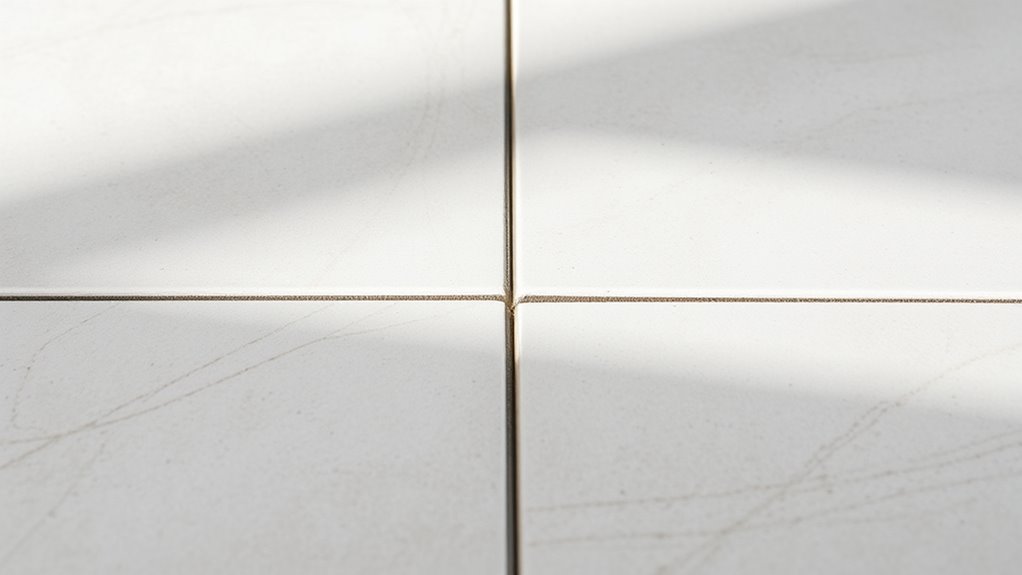
Even with careful planning, tile movement and joint issues can still occur, disrupting the seamless appearance you want. If you notice tiles shifting or cracking in the joints, don’t overlook it. First, identify whether the movement is due to improper installation, substrate issues, or environmental factors like temperature changes. For minor shifts, you might need to reapply grout or add flexible sealant to prevent further movement. Larger problems, such as cracked tiles or widening joints, require removing affected tiles and inspecting the substrate. Make sure you use the right expansion joints and allow for proper curing times during installation. Regular maintenance and quick repairs help maintain the integrity of your tiled surface, keeping it looking flawless and preventing long-term damage.
Frequently Asked Questions
How Often Should Expansion Joints Be Inspected for Wear?
You should inspect expansion joints at least once a year to guarantee they’re in good condition. Regular checks help you spot wear, cracks, or deterioration early, preventing potential tile damage or water infiltration. After heavy weather, temperature changes, or seismic events, consider inspecting them more frequently. Maintaining soft joints is essential to keep your tile installation lasting longer and looking perfect, so don’t skip these routine inspections.
Can Soft Joints Be Replaced After Tile Installation?
Yes, you can replace soft joints after tile installation. First, carefully remove the old joint material without damaging the surrounding tiles. Then, clean the area thoroughly to guarantee good adhesion. Apply fresh soft joint material, pressing it firmly into the joint. Allow it to cure properly before walking on the surface. Regular inspections help maintain the joints’ integrity, ensuring your tiled area stays durable and looking great.
What Are the Signs of Failed Expansion or Soft Joints?
You’ll notice failed expansion or soft joints if your tiles start cracking, buckling, or separating. Gaps may widen, and you might see uneven grout lines or tiles that seem loose or shift when you walk on them. These signs indicate the joints are no longer absorbing movement properly. Addressing these issues early helps prevent further damage, so keep an eye out for any unusual cracks or shifts in your tiled surface.
Are There Eco-Friendly Materials for Expansion and Soft Joints?
Yes, eco-friendly materials for expansion and soft joints do exist, acting like green guardians for your tiles. You can choose bio-based or recycled rubber, cork, or plant-based polymers, which absorb movement without harming the environment. These materials are durable and flexible, helping you maintain a perfect lip while reducing ecological impact. By selecting them, you’re not only protecting your tiles but also contributing to a greener planet.
How Do Climate Changes Affect Tile Joint Longevity?
Climate changes can substantially impact your tile joints’ longevity. When temperatures fluctuate, expansion and contraction occur, stressing the joints. Excess moisture from increased rain or humidity can cause deterioration or mold growth. Hotter weather accelerates material wear, while freezing temperatures can lead to cracking. To protect your tiles, make certain of proper joint flexibility, use weather-resistant materials, and maintain proper drainage. Regular inspections help catch issues early, extending your tile installation’s lifespan despite climate shifts.
Conclusion
By understanding how expansion and soft joints work, you can keep your tile surfaces looking flawless and prevent costly damage. Don’t worry if it seems complex at first—just follow proper placement and use the right materials. With a little attention to detail, you’ll enjoy a seamless, professional finish that lasts. Remember, maintaining these joints is simple and worth the effort for beautiful, long-lasting results.
